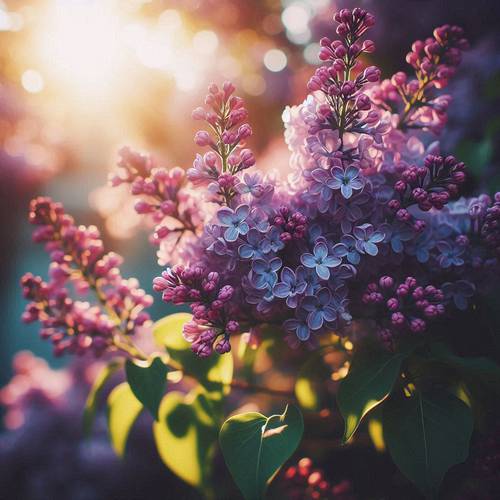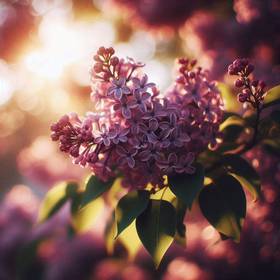History and Origin of Lilac Trees
Lilac trees, beloved for their fragrant blooms, have a rich history and origin. Native to southeastern Europe and Asia, lilacs were first cultivated over 1,000 years ago. They were introduced to Europe in the 16th century, becoming a favorite in royal gardens and among botanists.
By the 18th century, lilacs made their way to North America, brought by early settlers who cherished their beauty and scent. The genus name, Syringa, is derived from the Greek word "syrinx," meaning pipe, referencing the hollow stems. Today, lilac trees symbolize renewal and the arrival of spring, celebrated for their timeless charm and beauty.
By the 18th century, lilacs made their way to North America, brought by early settlers who cherished their beauty and scent. The genus name, Syringa, is derived from the Greek word "syrinx," meaning pipe, referencing the hollow stems. Today, lilac trees symbolize renewal and the arrival of spring, celebrated for their timeless charm and beauty.
Symbolism and Significance of Lilacs
Lilacs are beloved for their stunning beauty and rich symbolism. Representing renewal and the arrival of spring, lilacs are often associated with rebirth and fresh beginnings. Their fragrant blooms signify love and romance, making them popular in wedding bouquets and romantic settings.
Different colors of lilacs carry varied meanings: purple lilacs symbolize first love, white lilacs denote purity and innocence, and blue lilacs represent tranquility and happiness. Beyond their visual appeal, lilacs also hold cultural significance in literature and art, symbolizing fleeting moments of beauty and the delicate passage of time. These flowers beautifully capture the essence of nature's grace and elegance.
Different colors of lilacs carry varied meanings: purple lilacs symbolize first love, white lilacs denote purity and innocence, and blue lilacs represent tranquility and happiness. Beyond their visual appeal, lilacs also hold cultural significance in literature and art, symbolizing fleeting moments of beauty and the delicate passage of time. These flowers beautifully capture the essence of nature's grace and elegance.
Types of Lilac Trees: A Colorful Variety
Lilac trees are known for their stunning, fragrant blooms, but did you know there's a wide range of varieties available? From the classic Common Lilac to the unique Korean Lilac, there's a lilac type to suit every garden. Let's explore some of the most popular varieties:
Common Lilac (Syringa vulgaris)
The classic Common Lilac is the most widely recognized and loved lilac type. It boasts a dense, upright habit with fragrant, clusters of purple, pink, white, or even yellow flowers. This variety is known for its hardiness and is a reliable bloomer, making it a popular choice for gardens across the globe.
Persian Lilac (Syringa persica)
This delicate variety stands out with its slender, weeping branches and smaller, more fragrant blooms. Persian Lilacs often feature a more pastel color palette, including shades of lilac, pink, and white. Their graceful, cascading shape makes them ideal for smaller gardens or as accent plants.
Hungarian Lilac (Syringa josikaea)
Hungarian Lilacs are known for their vigorous growth habit and large, showy flower clusters. Their blooms typically appear in shades of pink to reddish-purple, filling the garden with a sweet fragrance. This variety is a great choice for adding bold color and a strong floral presence.
Korean Lilac (Syringa patula)
Korean Lilacs offer a unique blend of beauty and elegance. Their delicate, bell-shaped flowers are borne on arching branches, creating a cascading effect. This variety is known for its late blooming season, extending the lilac display in your garden. Their blooms typically come in shades of lilac, lavender, and pink.
Japanese Tree Lilac (Syringa reticulata)
As its name suggests, the Japanese Tree Lilac is a more robust variety that can reach tree-like proportions. It features large, showy clusters of white or pale lilac flowers that appear in late spring to early summer. This variety adds a stately presence to any landscape, providing a magnificent display of fragrant blossoms.
Common Lilac (Syringa vulgaris)
The classic Common Lilac is the most widely recognized and loved lilac type. It boasts a dense, upright habit with fragrant, clusters of purple, pink, white, or even yellow flowers. This variety is known for its hardiness and is a reliable bloomer, making it a popular choice for gardens across the globe.
Persian Lilac (Syringa persica)
This delicate variety stands out with its slender, weeping branches and smaller, more fragrant blooms. Persian Lilacs often feature a more pastel color palette, including shades of lilac, pink, and white. Their graceful, cascading shape makes them ideal for smaller gardens or as accent plants.
Hungarian Lilac (Syringa josikaea)
Hungarian Lilacs are known for their vigorous growth habit and large, showy flower clusters. Their blooms typically appear in shades of pink to reddish-purple, filling the garden with a sweet fragrance. This variety is a great choice for adding bold color and a strong floral presence.
Korean Lilac (Syringa patula)
Korean Lilacs offer a unique blend of beauty and elegance. Their delicate, bell-shaped flowers are borne on arching branches, creating a cascading effect. This variety is known for its late blooming season, extending the lilac display in your garden. Their blooms typically come in shades of lilac, lavender, and pink.
Japanese Tree Lilac (Syringa reticulata)
As its name suggests, the Japanese Tree Lilac is a more robust variety that can reach tree-like proportions. It features large, showy clusters of white or pale lilac flowers that appear in late spring to early summer. This variety adds a stately presence to any landscape, providing a magnificent display of fragrant blossoms.



